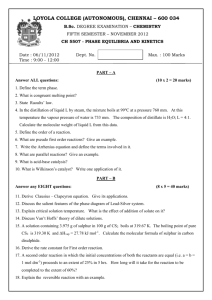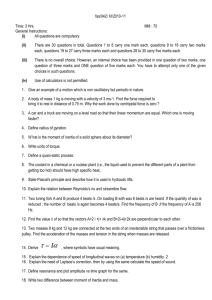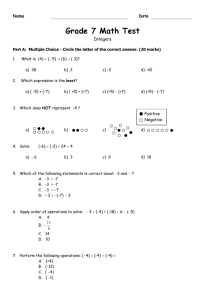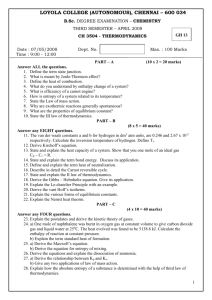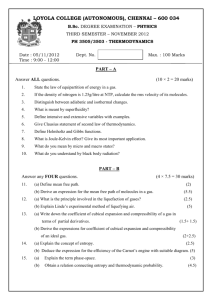paper 2014
advertisement
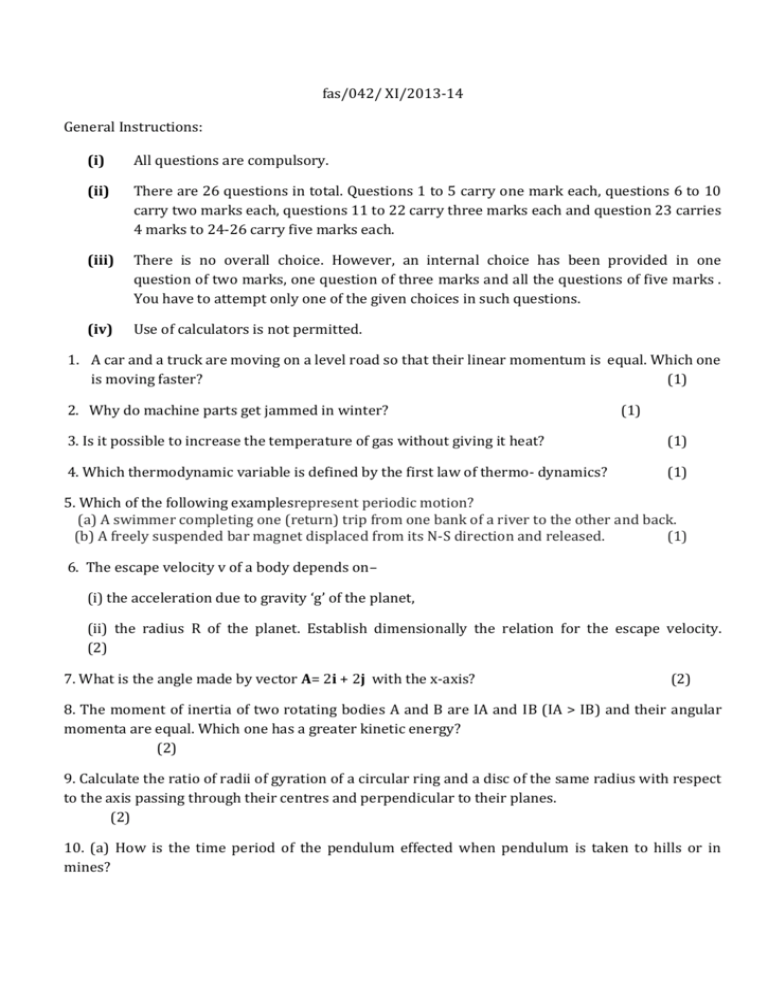
fas/042/ XI/2013-14 General Instructions: (i) All questions are compulsory. (ii) There are 26 questions in total. Questions 1 to 5 carry one mark each, questions 6 to 10 carry two marks each, questions 11 to 22 carry three marks each and question 23 carries 4 marks to 24-26 carry five marks each. (iii) There is no overall choice. However, an internal choice has been provided in one question of two marks, one question of three marks and all the questions of five marks . You have to attempt only one of the given choices in such questions. (iv) Use of calculators is not permitted. 1. A car and a truck are moving on a level road so that their linear momentum is equal. Which one is moving faster? (1) 2. Why do machine parts get jammed in winter? (1) 3. Is it possible to increase the temperature of gas without giving it heat? (1) 4. Which thermodynamic variable is defined by the first law of thermo- dynamics? (1) 5. Which of the following examplesrepresent periodic motion? (a) A swimmer completing one (return) trip from one bank of a river to the other and back. (b) A freely suspended bar magnet displaced from its N-S direction and released. (1) 6. The escape velocity v of a body depends on– (i) the acceleration due to gravity ‘g’ of the planet, (ii) the radius R of the planet. Establish dimensionally the relation for the escape velocity. (2) 7. What is the angle made by vector A= 2i + 2j with the x-axis? (2) 8. The moment of inertia of two rotating bodies A and B are IA and IB (IA > IB) and their angular momenta are equal. Which one has a greater kinetic energy? (2) 9. Calculate the ratio of radii of gyration of a circular ring and a disc of the same radius with respect to the axis passing through their centres and perpendicular to their planes. (2) 10. (a) How is the time period of the pendulum effected when pendulum is taken to hills or in mines? (b) What physical change occurs when a source of sound moves and the listener is stationary? (2) Or A 40 gm mass produces on extension of 4 cm in a vertical spring. A mass of 200 gm is suspended at its bottom and left pulling down. Calculate the frequency of its vibration. (2) 11. (a) Deduce the dimensional formula of Boltzmann constant. (b) Magnitude of force experienced by an object moving with speed v is given by F = kv2. Find the dimensions of k. (1+2) 12. Two vectors A and B are inclined to each other at an angle Θ. Using triangle law of vector addition, find the magnitude and direction of their resultant. (3) 13. (a) A passenger sitting in a car at rest, pushes the car from within. The car doesn’t move. Why? (b) Give the magnitude and di rections of the net force acting on a rain drop falling with a constant speed. (c) Why is it difficult to catch a cricket ball than a tennis ball even when both are moving with the same velocity? (3) 14. Derive an expression for acceleration of a cylinder of radius ‘r’ rolling down a rough inclined plane without slipping? (3) 15. (a) Two solid spheres of the same mass are made of metals of different densities. Which of them has a large moment of inertia about the diameter? (b) If earth contracts to half its radius what would be the length of the day at equator? (1+2) 16. (a) What will be the effect of increasing temperature on (i) angle of contact (ii) surface tension? (b) Define Capillarity. Derive an expression for the ascent of a liquid in a capillary tube. (1+2) 17. (a) Which is more elastic steel or rubber? (b) Define the term bulk modulus. Give its SI unit. Give its SI unit. Give the relation between bulk modulus and compressibility. (1+2) or (a) The earth without its atmosphere would be inhospitably cold. Why? (b) The coolant used in chemical or in a nuclear plant should have high specific heat. Why? (c) Explain why detergents should have small angle of contact? 18. Obtain an expression for work done in an isothermal process. (3) 19. State the law of equipartition of energy? Find the value of γ = Cp/Cv for a diatomic gas, where symbols have usual meaning. (3) 20. A transverse harmonic wave on a string is described by y(x, t) = 3.0 sin (36 t + 0.018 x +. π /4) where x and y are in cm and t in s. (b) What are its amplitude and frequency ? (c) What is the initial phase at the origin ? (d) What is the least distance between two successive crests in the wave ? (3) 21. (a) There are two springs, one delicate and another hard or stout one. For which spring, the frequency of the oscillator will be more? (b) Derive an expression for the time period of the vertical oscillations of two massless loaded springs connected in series. (1+2) 22. (a) What is the nature of the thermal change in air, when a sound wave propagates through it? (b) Using the corrected formula for the speed of sound in gas, explain its dependence on (i) pressure & (ii) temperature of the medium. (1+2) 23, A sports teacher was training the children for march-past. On their way they come across a bridge .Then the physical education teacher stopped the children from marching on the bridge. (a) Comment upon the values of sports teacher. b) Also explain the possible reason due to which he stopped the children from marching on the bridge. (4) 24. Show that there is always an excess pressure on the concave side of the meniscus of a liquid. Obtain an expression for the excess pressure inside (i) liquid bubble (ii) air bubble inside a liquid. Or State and prove Bernoulli’s theorem. (5) 25. (a) Why a gas has two principal specific heat capacities? (b) Which one is greater and why? (c) Establish the relation between two molar specific heat for a gas. (1+1+3) Or (a) Draw an indicator diagram depicting the steps of Carnot’s cycle. (b) A perfect Carnot engine utilizes an ideal gas the source temperature is 500K and sink temperature is 375K. If the engine takes 600k cal per cycle from the source, calculate (i) The efficiency of engine (ii) Work done per cycle (iii) Heat rejected to sink per cycle. (2+3) 26. (a) When are stationary waves produced? (b) The following figure shows two vibrating modes of an air column. Find the ratio of the frequencies of the two modes. (c) A pipe 20 cm long is closed at one end. Which harmonic mode of the pipe is resonantly excited by a 430 Hz source ? Will the same source be in resonance with the pipe if both ends are open? (speed of sound in air is 340 m s-1 ) (1+2+2) Or (a) What are beats? Prove that the number of beats per second is equal to the difference between the frequencies of the two superposing waves. (b) Two sitar strings A and B playing the note ‘Ga’ are slightly out of tune and produce beats of frequency 6 Hz. The tension in the string A is slightly reduced and the beat frequency is found reduced and the beat frequency is found to reduce to 3 Hz. If the original frequency of A is 324 Hz, what is the frequency of B? (3+2)



